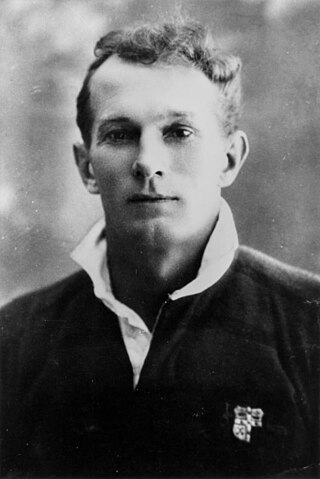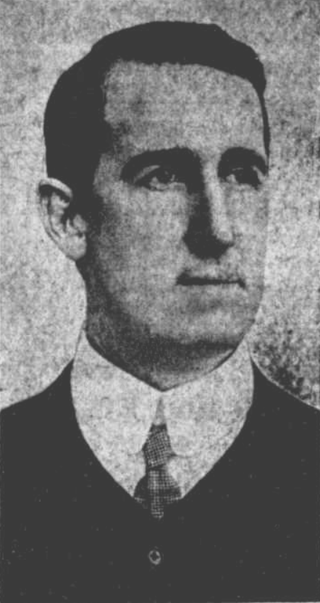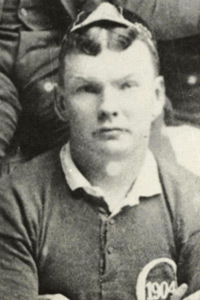Sporting life
Carew, a prop, claimed a total of four international rugby caps for Australia. All of those caps came in matches against Great Britain in 1899. [1] His debut game was against Great Britain, at Sydney, on 24 June 1899, the inaugural rugby Test match played by an Australian national representative side. He was one of only five Queenslanders selected in that first Test. Four weeks later he played in the second Test at Brisbane. His performance in that match was noted as excellent by the press. [4] He played in all four Tests of the series and made a Queensland state appearance against those same tourists in Brisbane on 1 July 1899.
Paddy represented Queensland in rugby from 1898 to 1901, and was named to the "Gallery of Great Players" on the occasion of Queensland Rugby Union's Jubilee in 1932 for representing the State on more than 10 occasions. He played a total of 17 matches: 16 against NSW as a forward and one against Great Britain. He captained Queensland in two games against NSW in 1901.
In 1903 Paddy joined Sydney's Eastern Suburbs Rugby Club and contributed to the club's first premiership that same year playing variously as a centre and forward. He was elected Easts' captain in 1904. He represented NSW against Queensland, and in 1903 against New Zealand.
At cricket he played as a right arm bowler and in five first-class matches with Queensland, between the 1899/1900 and 1902/03 seasons, took nine wickets at 35.77. [5] His brother James also represented Queensland at cricket. He played for Toowong in Brisbane district cricket and in 1903 he scored 233 for the club against South Brisbane, setting the record highest individual score in Queensland district cricket. [6]
Barry Muir was an Australian professional rugby league footballer and coach. An Australian and Queensland representative halfback, he played in 22 Tests between 1959 and 1964, as captain on two occasions.

In Queensland, Australian rules football dates back to the colonial era in 1866, with organised competitions being continuous since the 1900s. Today, it is most popular in South East Queensland and the Cairns Region. It is governed by AFL Queensland which coordinates 11 regional club competitions with more than 55,000 registered adult players.
This is an article that describes the history of Australian cricket from its known beginnings until the eve of the first-ever Test matches between Australia and England, which took place in the 1876–77 season.
Greg Veivers is an Australian former rugby league footballer who captained Australia in a Rugby League World Cup match in 1977. He represented Australia in seven World Cup matches from 1975 and 1977. He was a front-rower and a regular Queensland state representative from 1970 to 1978.

Herbert Walt Steinohrt was an Australian rugby league footballer who played in the 1920s and 1930s as a front row forward for the Australian national team. He played in 9 Tests between 1928 and 1932 as captain on 3 occasions. He has been widely regarded as one of the greatest forwards in rugby league history, being named in the "Queensland Rugby League's Team of the Century", Australian rugby league's 100 greatest players and Toowoomba and South West Team of the Century. Steinohrt was terrific on and off the field, he never lost his temper and was a smart tactician who never played the same game twice. The Valleys Roosters in the Toowoomba Rugby League Competition home ground is named Herb Stenohrt Oval in his honour.
Wilhelm Gustaf "Bill" Heidke (1883–1959) was a pioneer Australian rugby league player. He was a backline player for the Australian national team. He played in four Tests between 1908 and 1910, once as captain.
The 1980 State of Origin game was the first game between the Queensland Maroons and the New South Wales Blues rugby league teams to be played under "state of origin" selection rules. It was the third match of 1980s annual interstate series between the Blues and the Maroons, and was only allowed to go ahead because the first two matches were already won by New South Wales under established 'state of residency' rules. It was played on 8 July 1980 under the newly configured rules by which a player would represent his "state of origin", i.e. the state in which he was born or in which he started playing registered first grade rugby league football.

William Thomas "Poley" Evans was an Australian sportsman. He captained Queensland at first-class cricket and represented Australia in rugby union. He was born in Indooroopilly, Queensland and died at Buranda, Queensland.
Ernest William Currie was a New Zealand-born rugby union international for Australia and a first-class cricketer.
Rugby union is a popular sport in the Australian Capital Territory. Rugby football began to be played in the regions around what is now Canberra more than a century ago.

The 1899 British Isles tour to Australia was the fourth rugby union tour by a British Isles team and the second to Australia; though the first tour in 1888 was a private venture, making the 1899 tour the first official undertaking of Australia. It is retrospectively classed as one of the British Lions tours, as the Lions naming convention was not adopted until 1950.

Alfred John "Ginger" Colton was a rugby union player who represented Australia.

Robert Herman McCowan was a pioneer Australian rugby union player, a state and national representative fullback who played in his country's first Test series of 1899, captaining the national side on one occasion.

William Henry "Dooee" Tanner was a rugby union player who represented Australia.
Sinon Bernard "Sine" Boland, born Toowoomba, Queensland, was an Australian soldier, rower and rugby union player and one of the founders of Queensland Rugby League. In rugby union, he played for the Queensland and Australian team as a flanker and appeared in the inaugural series of Tests matches played by Australia in 1899. A Boer War and Gallipoli veteran, he once stood for the Queensland Parliament.

Arthur "Jack" Verge was a rugby union player who represented Australia, New South Wales and Sydney University. Playing as a fullback, Verge won both his caps for Australia in 1904 against a touring team from the British Isles. Although he was relatively light for his position, he was repeatedly praised for his tackling and all-round defensive work, and in attack, he was a fast and deceptive runner. His kicking, on the other hand, was inconsistent.
Country Cricket New South Wales is responsible for the development of cricket in regional New South Wales. It is under control of the governing body Cricket NSW.

Robert MacDonald was an Australian cricketer who played first-class cricket for Queensland and Leicestershire from 1894 to 1903. He was born in Clunes, Victoria, Australia, and died in Victoria, British Columbia. He was a dentist.
Women's rugby league is a popular women's sport in Australia. The sport has a high level of participation in the country both recreational and professional. Australian Rugby League Commission (ARLC) is the national governing body of the sport in Australia, organising the Australian Women's Rugby League, the Australian women's national team, and the nine state governing bodies of the game, among other duties. Women's participation of modern rugby league has been recorded since the early 1920s. It has since become one of Australia's most popular women's team sports.

William Francis Bradley was an Australian cricketer. He played fifteen first-class matches for Queensland between 1892-93 and 1899-1900 and was the States first first-class captain and wicket-keeper.












